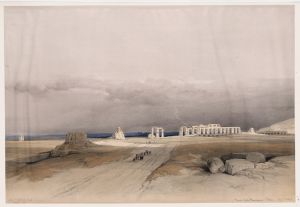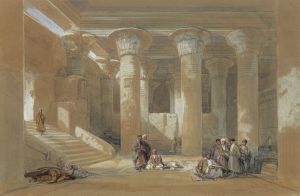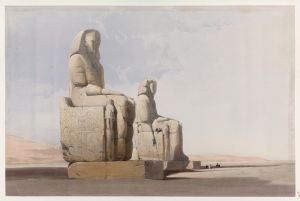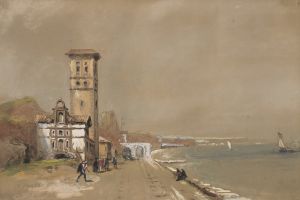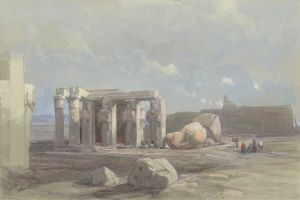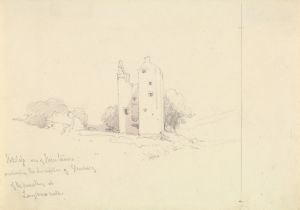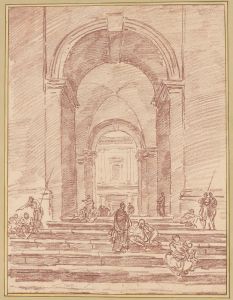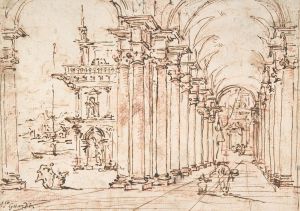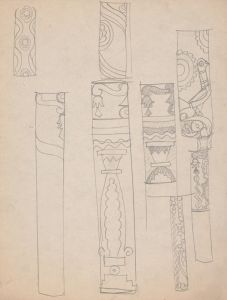
Part of the hall of columns at Karnak, Thebes.
A hand-painted replica of David Roberts’s masterpiece Part of the hall of columns at Karnak, Thebes., meticulously crafted by professional artists to capture the true essence of the original. Each piece is created with museum-quality canvas and rare mineral pigments, carefully painted by experienced artists with delicate brushstrokes and rich, layered colors to perfectly recreate the texture of the original artwork. Unlike machine-printed reproductions, this hand-painted version brings the painting to life, infused with the artist’s emotions and skill in every stroke. Whether for personal collection or home decoration, it instantly elevates the artistic atmosphere of any space.
"Part of the Hall of Columns at Karnak, Thebes" is a painting by the renowned Scottish artist David Roberts. David Roberts (1796-1864) was a prominent painter known for his detailed and accurate depictions of architectural and historical sites, particularly in the Middle East and North Africa. His works are celebrated for their precision and attention to detail, which were achieved through extensive travels and on-site sketches.
The painting in question depicts a section of the Great Hypostyle Hall in the Karnak Temple Complex, located in Thebes (modern-day Luxor), Egypt. The Karnak Temple Complex is one of the largest and most significant religious sites in ancient Egypt, dedicated primarily to the god Amun, along with his consort Mut and their son Khonsu. The complex was developed over many centuries, with contributions from various pharaohs, making it a rich tapestry of Egyptian architectural and artistic evolution.
The Great Hypostyle Hall, one of the most iconic features of the Karnak Temple, was constructed during the reigns of Pharaoh Seti I and his son Ramesses II in the 19th Dynasty (circa 1290-1224 BCE). The hall covers an area of approximately 5,000 square meters and contains 134 massive columns arranged in 16 rows. The central rows of columns are taller, reaching heights of about 24 meters, while the surrounding columns are slightly shorter. These columns are intricately carved with hieroglyphs and reliefs depicting various religious scenes and texts.
David Roberts visited Egypt in 1838-1839, during which he created numerous sketches and studies of the country's ancient monuments. These sketches served as the basis for his later lithographs and paintings. "Part of the Hall of Columns at Karnak, Thebes" is one such work, showcasing Roberts' skill in capturing the grandeur and detail of the ancient structures. The painting highlights the scale and intricacy of the columns, with their elaborate carvings and the play of light and shadow within the hall.
Roberts' works, including this painting, were published in a series of lithographs titled "Egypt and Nubia" between 1846 and 1849. These publications were highly influential in Europe, providing many people with their first visual impressions of the ancient Egyptian sites. Roberts' detailed and accurate representations contributed significantly to the Western understanding and appreciation of Egyptian antiquities.
The painting "Part of the Hall of Columns at Karnak, Thebes" is an important historical document, capturing a moment in time and preserving the grandeur of one of Egypt's most significant architectural achievements. It reflects both the artistic skill of David Roberts and the enduring legacy of ancient Egyptian civilization.





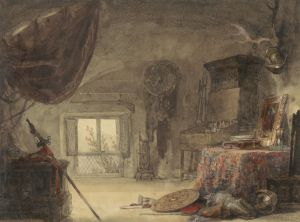
![Colossus in front of Temple of Wady Saboua [Wadi al-Sabua], Nubia.](/imgs/217471/s/david-roberts-colossus-in-front-of-temple-of-wady-saboua-wadi-alsabua-nubia-503a97c9.jpg)
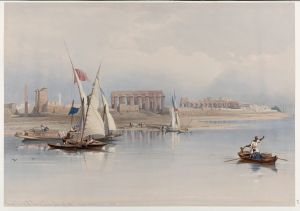
![One of two colossal statues of Rameses [sic] II. Entrance to the Temple at Luxor.](/imgs/217522/s/david-roberts-one-of-two-colossal-statues-of-rameses-sic-ii-entrance-to-the-temple-at-luxor-473c42e1.jpg)
